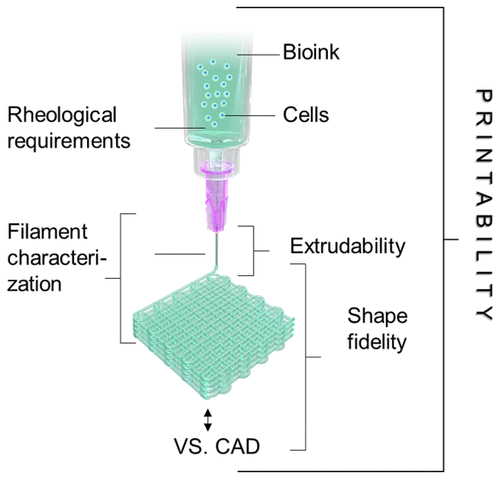当前位置:
X-MOL 学术
›
Chem. Rev.
›
论文详情
Our official English website, www.x-mol.net, welcomes your
feedback! (Note: you will need to create a separate account there.)
Printability and Shape Fidelity of Bioinks in 3D Bioprinting.
Chemical Reviews ( IF 51.4 ) Pub Date : 2020-08-28 , DOI: 10.1021/acs.chemrev.0c00084 Andrea Schwab 1 , Riccardo Levato 2, 3 , Matteo D'Este 1 , Susanna Piluso 2, 4 , David Eglin 1 , Jos Malda 2, 3
Chemical Reviews ( IF 51.4 ) Pub Date : 2020-08-28 , DOI: 10.1021/acs.chemrev.0c00084 Andrea Schwab 1 , Riccardo Levato 2, 3 , Matteo D'Este 1 , Susanna Piluso 2, 4 , David Eglin 1 , Jos Malda 2, 3
Affiliation

|
Three-dimensional bioprinting uses additive manufacturing techniques for the automated fabrication of hierarchically organized living constructs. The building blocks are often hydrogel-based bioinks, which need to be printed into structures with high shape fidelity to the intended computer-aided design. For optimal cell performance, relatively soft and printable inks are preferred, although these undergo significant deformation during the printing process, which may impair shape fidelity. While the concept of good or poor printability seems rather intuitive, its quantitative definition lacks consensus and depends on multiple rheological and chemical parameters of the ink. This review discusses qualitative and quantitative methodologies to evaluate printability of bioinks for extrusion- and lithography-based bioprinting. The physicochemical parameters influencing shape fidelity are discussed, together with their importance in establishing new models, predictive tools and printing methods that are deemed instrumental for the design of next-generation bioinks, and for reproducible comparison of their structural performance.
中文翻译:

3D 生物打印中生物墨水的可打印性和形状保真度。
三维生物打印使用增材制造技术来自动制造分层组织的生命结构。构建模块通常是基于水凝胶的生物墨水,需要将其打印成具有高形状保真度的结构,以符合预期的计算机辅助设计。为了获得最佳的电池性能,优选相对柔软且可印刷的油墨,尽管这些油墨在印刷过程中会经历显着的变形,这可能会损害形状保真度。虽然印刷适性好坏的概念似乎相当直观,但其定量定义缺乏共识,并且取决于油墨的多种流变学和化学参数。本综述讨论了评估基于挤出和平版印刷的生物墨水的可印刷性的定性和定量方法。讨论了影响形状保真度的物理化学参数,以及它们在建立新模型、预测工具和打印方法中的重要性,这些模型、预测工具和打印方法被认为有助于设计下一代生物墨水,并可重复比较其结构性能。
更新日期:2020-10-15
中文翻译:

3D 生物打印中生物墨水的可打印性和形状保真度。
三维生物打印使用增材制造技术来自动制造分层组织的生命结构。构建模块通常是基于水凝胶的生物墨水,需要将其打印成具有高形状保真度的结构,以符合预期的计算机辅助设计。为了获得最佳的电池性能,优选相对柔软且可印刷的油墨,尽管这些油墨在印刷过程中会经历显着的变形,这可能会损害形状保真度。虽然印刷适性好坏的概念似乎相当直观,但其定量定义缺乏共识,并且取决于油墨的多种流变学和化学参数。本综述讨论了评估基于挤出和平版印刷的生物墨水的可印刷性的定性和定量方法。讨论了影响形状保真度的物理化学参数,以及它们在建立新模型、预测工具和打印方法中的重要性,这些模型、预测工具和打印方法被认为有助于设计下一代生物墨水,并可重复比较其结构性能。











































 京公网安备 11010802027423号
京公网安备 11010802027423号